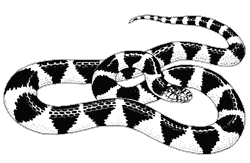Kingsnake
(Lampropeltis spp.)
Order: Squamata
Family: Colubridae (colubrid snakes)
Other common names: desert kingsnake, black kingsnake, California kingsnake
Spanish names: culebra
Distinguishing Features
A long, slender, harmless snake, the common kingsnake reaches lengths of approximately 3¼ feet (100 cm) in Arizona, although rare specimens reach 6 feet (180 cm). In most of the Sonoran Desert it is a dark brown or black snake with narrower bands of yellow, white, or cream going around the body, widening on the belly. However, there is considerable variation in pattern throughout the range. In some parts of the range (southern Arizona) the common kingsnake is entirely dark with no light bands, while in other areas the bands degenerate into a speckled appearance. In California, this species can have a single stripe that runs from behind the head to the tail. The scales are smooth and glossy in appearance.

Range
This is a widespread species, found coast-to-coast in the United States from southern New Jersey to Southern Florida, and west through California and southern Oregon. In Mexico this species is found through much of Baja California and mainland Mexico, south to northern Sinaloa, San Luis Potosí and northern Tamaulipas.
Habitat
A habitat generalist, the common kingsnake has been found in deserts, riparian areas, woodlands, forests, and farmland from sea level to 7000 feet (2100 m).
Life History
Active in early morning and late afternoon when the weather is mild, the common kingsnake becomes nocturnal with the onset of extreme heat in summer. An opportunistic feeder, it will eat many things including lizards, birds, mammals, frogs, bird eggs, and snakes (including rattlesnakes). When a rattlesnake encounters a kingsnake, or its odor, it will not rattle. Instead it slightly elevates the front portion of its body in a line horizontal to the ground, making itself appear large, a behavior known as body bridging. Once seen, body bridging is easily distinguished from the more frequently seen defensive coil of all rattlesnakes. Body bridging does not deter a hungry kingsnake. The kingsnake, highly tolerant of and perhaps immune to the rattlesnake’s venom, will bite the rattlesnake behind the head; coils of the kingsnake’s body are then thrown around the rattlesnake, constricting it until death results. Sometimes the kingsnake will begin consuming the rattlesnake before it is dead.
When confronted, the common kingsnake may hiss, strike, and rattle its tail or hide its head in coils of its body, releasing a foul-smelling musk. Five to 17 eggs are laid in mid summer, hatching occurs in late summer and early fall.










